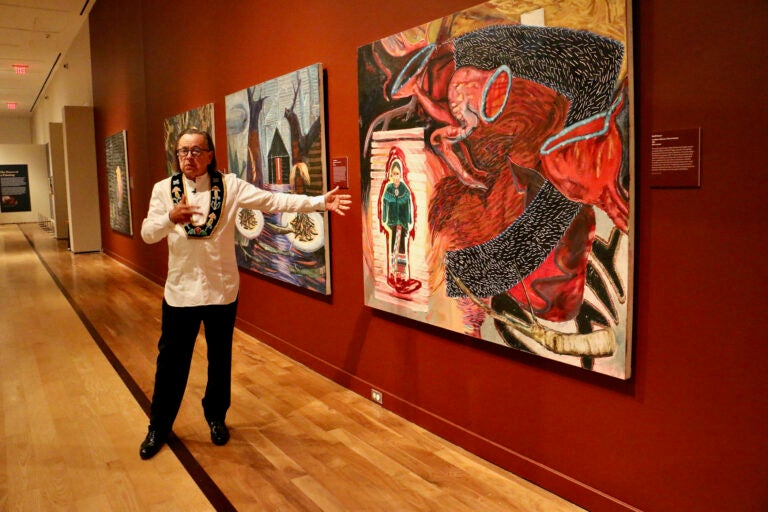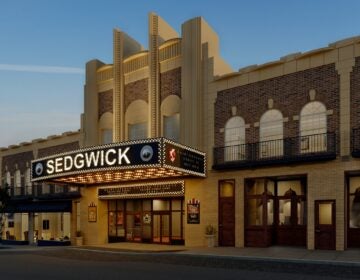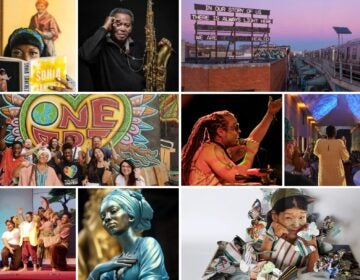Delaware study aims to revitalize state’s arts and culture with new online map to boost economy and tourism
A new study from the Delaware Arts Alliance unveils an ambitious plan to support the arts and cultural sector with a new online mapping hub.
Listen 1:24
Joe Baker talks about his paintings, one of which depicts his grandmother performing the last Doll Dance in the early 1900s. Baker is one of four artists from the Delaware Tribe of Indians whose work is featured in ''Never Broken: Visualizing Lenape Histories,'' at the Michener Museum. (Emma Lee/WHYY)
From Philly and the Pa. suburbs to South Jersey and Delaware, what would you like WHYY News to cover? Let us know!
Over the past two years, the Delaware Arts Alliance has been working on the Creative Economy Advancement and Tourism Plan to enhance the state’s creative economy and cultural tourism sector. The effort is supported by a $1 million grant from the Economic Development Administration’s American Rescue Plan.
“After over two years of work and research, we are beyond excited to roll out this unprecedented research, asset map and action plan,” said Delaware Arts Alliance director Neil Kirschling. “We believe this plan is a roadmap to ensure Delaware is seen as a cultural tourism destination, a home to artists of all walks of life and home to a vibrant community of creative professionals.”
He noted that the pandemic significantly impacted the arts sector and highlighted the need for a comprehensive plan at the state and county levels. During this period, securing funding and maintaining operations became challenging for artists and art organizations.
“As we move out of the pandemic, we are intentionally putting the arts into economic terms because we know that it is important to remind people that the arts puts people to work,” he said. “They’re contributing to our state tourism, they’re contributing to our output and employment figures and, therefore, deserve to be integrated into all of these other economic development strategies that we have as a state.”
Backing Krischling’s view on the arts sector’s impact is the Arts and Economic Prosperity 6 (AEP6) study from the Delaware Division of the Arts. This study provides a detailed examination of the non-profit arts and culture sector.
According to AEP6, the total industry expenditures for the fiscal year 2022 amounted to about $210 million, supporting more than 3,330 jobs.
However, the Art Alliance’s CREATE plan – which will officially be unveiled July 30 – adopts a broader approach by including for-profit arts organizations and individual artists, uncovering larger figures and showing greater resiliency in recovering from challenges.
“We learned through this study that, in 2021, Delaware’s creative economy supported 18,551 local jobs, which is about 4.1% of the state’s employment,” Krischling highlighted. “We also looked at general economic output and learned in 2020 that the sector added $2.2 billion to our economy and that largely we’ve recovered since pre-pandemic levels.”
As part of their study, the organization aimed to develop a map that serves as a central hub for art enthusiasts and those interested in art-related resources. They have released a map offering easy access to artist locations offering design and creative services, music recording and publishing, cultural and natural heritage, and more.
In addition to the map, the study offers 25 actionable recommendations to support the arts and culture sector. Some of these policy recommendations include creating pay guidelines for creatives, ensuring equitable funding and offering professional development and training.
“It includes developing a statewide cultural economy brand. Some of our other recommendations look at developing the state’s creative economy by establishing creative hubs in each county by updating permitting processes for public events,” Krischling said. “We’re also looking to provide support for the industry including creative economy and economic development conversations by creating some government position that supports the arts.”
Overall, DAA has two goals: supporting the arts sector and attracting tourists to the state.
“We want Delaware to import tourists, right, not to be an exporter of Delawareans who leave to go enjoy arts and culture in other states,” he emphasized. “We’re hoping we’ll be able to stimulate economic activity, implementing the recommendations in this plan will help the sector to grow.
Their full report, which outlines their findings and recommendations, is scheduled for release next week.

Show your support for local public media
WHYY is your source for fact-based, in-depth journalism and information. As a nonprofit organization, we rely on financial support from readers like you. Please give today.






